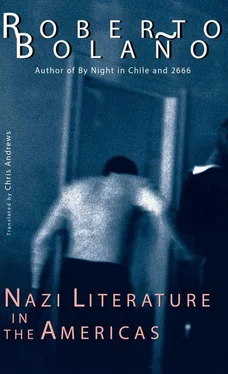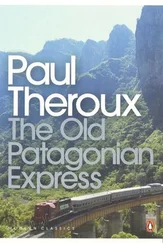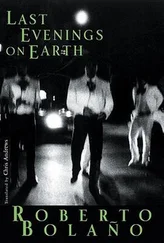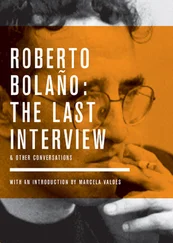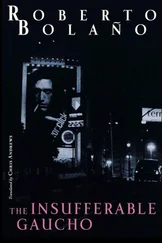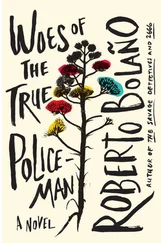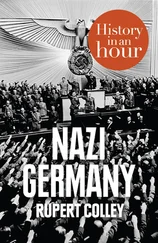In 1971, Schiaffino visited the widow Mendiluce, but there are no records, photographic or written, of their meeting. In 1972, he published The Path to Glory , a series of forty-five poems, each one examining the life of a different Boca Juniors player. Like Cower, Hounds! the book included an obliging preface by Dr. Pérez Heredia and a nihil obstat issued by the vice-president of the soccer club. The publication was financed by the members of Schiaffino’s gang, who paid a subscription, and the remaining copies were sold in the vicinity of Boca’s Bombonera stadium on match days. This time the sportswriters paid him some attention: two magazines deemed The Path to Glory worthy of a review, and when Dr. Pestalozzi’s radio program 100 % Soccer organized a round table on the critical state of the national game, Schiaffino was invited to participate. On the radio, in the company of well-known sports personalities, he was restrained.
In 1975 he delivered his next collection of poetry to the printer. Entitled Like Wild Bulls , it has a gaucho-like tone, which can reasonably be attributed to the influence of Hernández, Giraldes and Carriego. In it, Schiaffino recounts, sometimes in great detail, how he led the gang on excursions to various places in the province of Buenos Aires, as well as on two trips to Córdoba and Rosario, which resulted in victories for the visiting team and their hoarse supporters as well as sundry skirmishes, none of which degenerated into street battles, although a number of lessons were administered to isolated elements of the “enemy forces.” In spite of its eminently bellicose tone, Like Wild Bulls is Schiaffino’s most successful work. Exhibiting a degree of freedom and spontaneity unmatched elsewhere in his writing, it gives the reader a clear sense of the young poet’s character and his bond with “the virginal spaces of the Fatherland.”
In 1975, after the fusion of his gang with those of Honesto García and Juan Carlos Lentini, Schiaffino launched the triennial magazine With Boca , which thenceforth was to serve as a mouthpiece for the expression and diffusion of his ideas. In the first number of 1976, he published “Jews Out”: out of the soccer stadiums naturally, not out of Argentina, but the essay was widely misunderstood and earned him many enemies. As did “Memoirs of a Malcontent Fan,” published in the third number of 1976, in which Schiaffino, pretending to be a River Plate fan, pokes fun at the players and supporters of Boca’s traditional rival. Parts II, III and IV of the “Memoirs” followed in the first and third numbers of 1977 and the first number of 1978. Unanimously acclaimed by the readers of With Boca , they were quoted by Colonel (retired) Persio de la Fuente in an article on the idiom of the Latin American picaresque in the University of Buenos Aires Semiotics Review .
1978 was Schiaffino’s year of glory. Argentina won the World Cup for the first time and the gang celebrated in the streets, which were transformed for the occasion into a vast parade ground. It was the year of “A Toast to the Boys,” an excessive, allegorical poem, in which Schiaffino imagines a country setting forth to meet its destiny, united like one huge soccer gang. It was also the year in which “respectable,” “adult” avenues opened up for him: his poem was widely reviewed, and not just in sports magazines. A Buenos Aires radio station offered him a job as a commentator; a newspaper with close links to the government offered him a weekly column on youth issues. Schiaffino accepted all the offers but before long his impetuous pen had alienated everyone. At the radio station and the newspaper it soon became clear that leading the Boca boys was more important to Schiaffino than being on any payroll. Broken ribs and windows resulted from the conflict, and the first of a long series of prison terms.
Without the support of his benefactors, Schiaffino’s lyric inspiration seems to have dried up. From 1978 to 1982, he devoted himself almost exclusively to the gang and to bringing out With Boca , in which he continued to rail against the ills besetting soccer and Argentina.
His authority over the fan base remained undiminished. Under his leadership the Boca gang grew in numbers and strength as never before. His prestige, albeit obscure and secret, was unrivalled: the family album still contains photos of Schiaffino with players and club officials.
He died of a heart attack in 1982, while listening to one of the last reports on the Falklands War.
ARGENTINO (“FATSO”) SCHIAFFINO
Buenos Aires, 1956–Detroit, 2015
The arc of Argentino Schiaffino’s life has prompted comparisons, over the years, with varied and often incompatible figures from the worlds of literature and sports. Thus, in 1978, a certain Palito Kruger, writing in the third number of With Boca , asserted that Schiaffino’s life and work were comparable to those of Rimbaud. In 1982, in a different number of the same magazine, Argentino Schiaffino was referred to as the Latin American equivalent of Dionisio Ridruejo. In the preface to his 1995 anthology Occult Poets of Argentina , Professor González Irujo put him on a par with Baldomero Fernández, and with his own personal friends. Letters to Buenos Aires newspapers hailed him as the only civic figure in the same league as Maradona. And in 2015, a short death notice written by John Castellano for a newspaper in Selma (Alabama) coupled him with the tragic figure of Ringo Bonavena.
All the comparisons are justified, to a certain degree, by the ups and downs of Argentino Schiaffino’s life and work.
We know that he grew up in the shadow of his brother, who taught him to love soccer, recruited him as a Boca fan, and interested him in the mysteries of poetry. The two brothers were, however, notably different. Italo Schiaffino was tall, well built, authoritarian, unemotional and unimaginative. He cut an imposing figure: wiry, angular, with a slightly cadaverous air, although from the age of twenty-eight, perhaps because of a hormonal imbalance, he began to grow dangerously fat, eventually reaching a fatal degree of obesity. Argentino Schiaffino was on the shorter side of average, plump (thence the affectionate nickname “Fatso,” by which he was known until the day he died), sociable and bold by nature, charismatic though hardly authoritarian.
He began to write poetry at the age of thirteen. At sixteen, while his elder brother was making his name with The Path to Glory , he produced fifty mimeographed copies of his first book, at his own expense and risk. It was a series of thirty epigrams entitled Anthology of the Best Argentinean Jokes ; over one weekend he personally sold all the copies to members of the Boca gangs. In April 1973, employing the same editorial strategy, he published his story “The Invasion of Chile,” an exercise in black humor (some passages resemble a splatter movie script) about a hypothetical war between the two republics. In December of the same year he published the manifesto We’re Not Going to Take It , in which he attacked the league’s umpires, whom he accused of bias, lack of physical fitness, and, in some cases, of drug use.
He began the year 1974 by publishing the collection Iron Youth (fifty mimeographed copies): dense, militaristic poems with marching-song rhythms, which, if nothing else, obliged Schiaffino to venture beyond the bounds of his natural thematic domains: soccer and humor. He followed up with a play , The Presidential Summit, or What Can We Do to Turn This Around? In this five-act farce, heads of state and diplomats from various Latin American nations meet in a hotel room somewhere in Germany to discuss options for restoring the natural and traditional supremacy of Latin American soccer, which is under threat from the European total-football approach. The play, which is extremely long, recalls a certain strain of avant-garde theater, from Adamov, Genet and Grotowski to Copi and Savary, although it is unlikely (though not impossible) that Fatso ever set foot in the sort of establishment given to the production of such plays. The following are only a few of the scenes: 1. A monologue about the etymology of the words “peace” and “art” delivered by the Venezuelan cultural attaché. 2. The rape of the Nicaraguan ambassador in one of the hotel bathrooms by the presidents of Nicaragua, Colombia and Haiti. 3. A tango danced by the presidents of Argentina and Chile. 4. The Uruguayan ambassador’s peculiar interpretation of the prophecies of Nostradamus. 5. A masturbation contest organized by the presidents, with three categories: thickness (won by the Ecuadorian ambassador); length (won by the Brazilian ambassador); and, most importantly, distance covered by semen (won by the Argentinean ambassador). 6. The president of Costa Rica’s subsequent irritation and condemnation of such contests as “scatology in the poorest taste.” 7. The arrival of the German whores. 8. Mass brawling, chaos and exhaustion. 9. The arrival of the dawn, a “pink dawn that intensifies the fatigue of the bigwigs who finally come to understand their defeat.” 10. The president of Argentina’s solitary breakfast, after which he lets off a series of resounding farts, then climbs into bed and falls asleep.
Читать дальше
